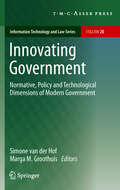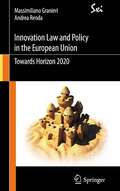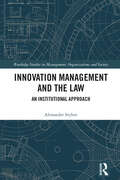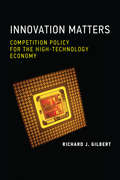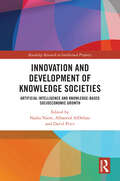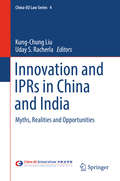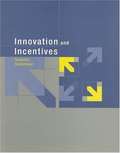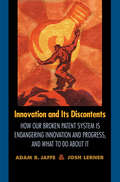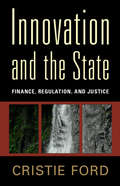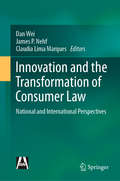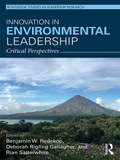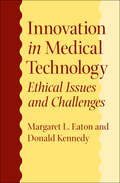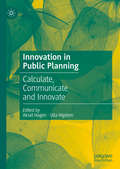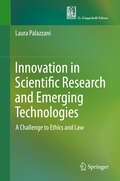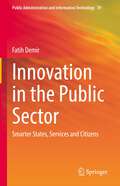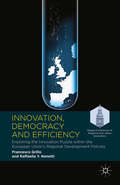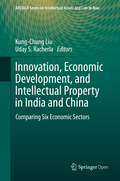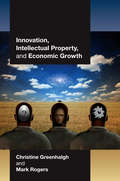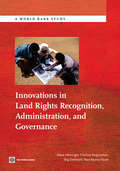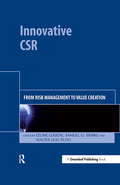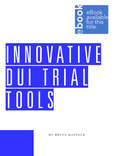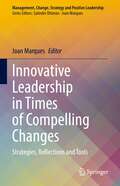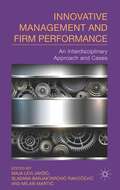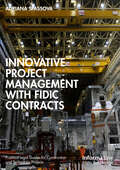- Table View
- List View
Innovating Government
by Marga M. Groothuis Simone van der HofThe aim of this book is to analyze four dimensions of innovating government and the use of new technologies: legal, ethical, policy and technological dimensions. By joining authors from a diversity of backgrounds (law, ethics, public administration, political science, sociology, communications science, information science, and computer science) in one book, readers (academics, policy makers, legislators and others) are confronted with a variety of disciplinary perspectives on persistent themes, like privacy, biometrics, surveillance, e-democracy, electronic government, and identity management, that are central to today's evolution of new modes of modern government.
Innovation Law and Policy in the European Union: Towards Horizon 2020
by Massimiliano Granieri Andrea RendaThe book provides a critical overview of innovation policy in Europe and a synopsis of the current institutional framework of Europe shaped after the Europe2020 strategy and in view of the upcoming Horizon2020 agenda. What emerges is a rather gloomy outlook for the future of Europe's innovation, unless EU institutions and Member States will decide to streamline existing policies and build a "layered" model of innovation, in which governments act as investors in key enabling infrastructure such as ICT and education; as enablers of large technology markets where researchers and entrepreneurs can meet; and as purchasers of innovation when key societal challenges are at stake. The book contains proposals for the future innovation strategy of the EU and a specific analysis of areas such as the unitary patent, the transfer of technology (particularly as far as climate-related technologies and IP markets are concerned), standardization, and the digital agenda.
Innovation Management and the Law: An Institutional Approach (Routledge Studies in Management, Organizations and Society)
by Alexander StyhreIn economic theory and in management studies, innovation is widely regarded as the motor of economic activities and as being the primary source of renewal in the economic system. This view emphasizes how innovation work is organized in specialized teams inside the firm, or, alternatively, located to start-ups and similar small ventures that are strongly incentivized to innovate to survive. Rather than assuming that innovation work is a mere product of incentives provided by the market system, propelled by the individual and collective skills of the innovation team participants and the resources that they mobilize in their work, this volume examines how a market for innovation ideas is being constructed on the basis of policy making and legislative activities. Innovation Management and the Law examines how the idea of value creation is understood to be a matter of innovation activities and how such innovation activities are premised on legal rights that create not only incentives, corporations, and markets, but also more widely signal to market actors what kind of activities are consistent with policy makers’ economic and social welfare objectives. The volume thus adds to the innovation management literature by introducing a comprehensive analysis of the patent system, illustrating that the patent system is itself an institution and that it should be examined in such terms when studying how innovations are generated on the basis of team production activities and legal rights that are enforceable. It will be of interest to researchers, academics, professionals, and advanced students in the fields of management, economic theory, and law.
Innovation Matters: Competition Policy for the High-Technology Economy
by Richard J. GilbertA proposal for moving from price-centric to innovation-centric competition policy, reviewing theory and available evidence on economic incentives for innovation.Competition policy and antitrust enforcement have traditionally focused on prices rather than innovation. Economic theory shows the ways that price competition benefits consumers, and courts, antitrust agencies, and economists have developed tools for the quantitative evaluation of price impacts. Antitrust law does not preclude interventions to encourage innovation, but over time the interpretation of the laws has raised obstacles to enforcement policies for innovation. In this book, economist Richard Gilbert proposes a shift from price-centric to innovation-centric competition policy. Antitrust enforcement should be concerned with protecting incentives for innovation and preserving opportunities for dynamic, rather than static, competition. In a high-technology economy, Gilbert argues, innovation matters.
Innovation and Development of Knowledge Societies: Artificial Intelligence and Knowledge-Based Socioeconomic Growth (Routledge Research in Intellectual Property)
by Nadia Naim, Alhanoof AlDebasi and David PriceThis book examines the role that intellectual property plays in fostering innovation within knowledge societies, with a particular focus on the role of emerging technologies such as Artificial Intelligence tools.Creativity and the generation of new knowledge across the broad spectrum of intellectual property are essential sources of growth for knowledge societies. This includes the major areas of copyright, inventions and patents, trademarks and geographical indications. This book acknowledges the societal and cultural character of knowledge societies, discussing how Intellectual Property (IP) Law plays a pivotal role in safeguarding innovation, thereby fostering evolution. As emerging technologies and artificial intelligence redefine the landscape, the book identifies both new challenges and opportunities in enhancing innovation prowess and nurturing knowledge societies. Suggesting regulations which prioritise copyright, trademarks and patents as fundamental instruments in international commerce, the book presents a framework for IP Law through which knowledge societies can thrive.The book will appeal to researchers in the field of Intellectual Property Law, international law, business law and emerging technologies such as AI.
Innovation and IPRs in China and India
by Kung-Chung Liu Uday S. RacherlaThis book examines the two most populous nations on earth - India and China - in an effort to demystify the interaction between intellectual property rights (IPR) regimes, innovation and economic growth by critically looking at the economic and legal realities. In addition, it analyzes the question of how innovation can best be transformed into IPR, and how IPR can best be exploited to encourage innovation. Comparing and contrasting these two giant nations can be highly beneficial as China and India were the two fastest-growing economies in the last three decades, and together their populations make up one third of the world's total population; as such, exploring how to sustain their growth via innovation and commercialization of IPR could have a tremendous positive impact on global well-being. While a study of these two mega countries with such diverse dimensions and magnitudes can never be truly comprehensive, this joint effort by scholars from law, business management and economics disciplines that pursues an empirical approach makes a valuable contribution. Divided into three parts, the first offers an in-depth doctrinal and empirical analysis. The second part exclusively focuses on India, while the last is dedicated to China.
Innovation and Incentives
by Suzanne ScotchmerInterest in intellectual property and other institutions that promote innovation exploded during the 1990s. Innovation and Incentives provides a clear and wide-ranging introduction to the economics of innovation, suitable for teaching at both the advanced undergraduate and graduate levels. It will also be useful to legal and economics professionals. Written by an expert on intellectual property and industrial organization, the book achieves a balanced mix of institutional details, examples, and theory. Analytical, empirical, or institutional factors can be given different emphases at different levels of study. Innovation and Incentives presents the historical, legal, and institutional contexts in which innovation takes place. After a historical overview of the institutions that support innovation, ranging from ancient history through today's government funding and hybrid institutions, the book discusses knowledge as a public good, the economic design of intellectual property, different models of cumulative innovation, the relation of competition to licensing and joint ventures, patent and copyright enforcement and litigation, private/public funding relationships, patent values and the return on R&D investment, intellectual property issues arising from direct and indirect network externalities, and globalization. The text presents technical and abstract analysis and at the same time sheds light on current controversies and policy-relevant topics, including the difficulty of enforcing copyright in the digital age and international protection of intellectual property.
Innovation and Its Discontents: How Our Broken Patent System is Endangering Innovation and Progress, and What to Do About It
by Josh Lerner Adam B. JaffeThe United States patent system has become sand rather than lubricant in the wheels of American progress. Such is the premise behind this provocative and timely book by two of the nation's leading experts on patents and economic innovation. Innovation and Its Discontents tells the story of how recent changes in patenting--an institutional process that was created to nurture innovation--have wreaked havoc on innovators, businesses, and economic productivity. Jaffe and Lerner, who have spent the past two decades studying the patent system, show how legal changes initiated in the 1980s converted the system from a stimulator of innovation to a creator of litigation and uncertainty that threatens the innovation process itself. In one telling vignette, Jaffe and Lerner cite a patent litigation campaign brought by a a semi-conductor chip designer that claims control of an entire category of computer memory chips. The firm's claims are based on a modest 15-year old invention, whose scope and influenced were broadened by secretly manipulating an industry-wide cooperative standard-setting body. Such cases are largely the result of two changes in the patent climate, Jaffe and Lerner contend. First, new laws have made it easier for businesses and inventors to secure patents on products of all kinds, and second, the laws have tilted the table to favor patent holders, no matter how tenuous their claims. After analyzing the economic incentives created by the current policies, Jaffe and Lerner suggest a three-pronged solution for restoring the patent system: create incentives to motivate parties who have information about the novelty of a patent; provide multiple levels of patent review; and replace juries with judges and special masters to preside over certain aspects of infringement cases. Well-argued and engagingly written, Innovation and Its Discontents offers a fresh approach for enhancing both the nation's creativity and its economic growth.
Innovation and the State: Finance, Regulation, and Justice
by Cristie FordFrom social media to mortgage-backed securities, innovation carries both risk and opportunity. Groups of people win, and lose, when innovation changes the ground rules. Looking beyond formal politics, this new book by Cristie Ford argues that we need to recognize innovation, and financial innovation in particular, as a central challenge for regulation. Regulation is at the leading edge of politics and policy in ways that we have not yet fully grasped. Seemingly innocuous regulatory design choices have clear and profound practical ramifications for many of our most cherished social commitments. Innovation is a complex phenomenon that needs to be understood not only in technical terms, but also in human ones. Using financial regulation as her primary example, Ford argues for a fresh approach to regulation, which recognizes innovation for the regulatory challenge that it is, and which binds our cherished social values and our regulatory tools ever more tightly together.
Innovation and the Transformation of Consumer Law: National and International Perspectives
by Dan Wei Claudia Lima Marques James P. NehfThis book covers technologies that pose new challenges for consumer policy, creative developments that can help protect consumers’ economic interests, innovative approaches to addressing perennial consumer concerns, and the challenges entailed by emerging ways of creating and delivering consumer products and services. In addition, it reflects on past successes and failures of consumer law and policy, explores opportunities for moving consumer law in a different direction, and discusses potential threats to consumer welfare, especially in connection with the changing political landscape in many parts of the world. Several chapters examine consumer law in individual countries, while others have an international focus.
Innovation in Environmental Leadership: Critical Perspectives (Routledge Studies in Leadership Research)
by Benjamin W. Redekop Deborah Rigling Gallagher Rian SatterwhiteInnovation in Environmental Leadership offers innovative approaches to leadership from a post-industrial and ecological vantage point. Chapters in this collection are written by leading scholars and practitioners of environmental leadership from around the globe, and are informed by a variety of critical perspectives, including post-heroic approaches, systems thinking, and the emerging insights of Critical Leadership Studies (CLS). By taking the natural environment seriously as a foundational context for leadership, Innovation in Environmental Leadership offers fresh insights and compelling visions of leadership pertinent to 21st century environmental and social challenges. Concepts and understandings of leadership emerged as part of an extractive industrial system; this work asks its readers to re-think what leadership looks like in an ecologically sustainable biological system. This book provides fresh insights and critical perspectives on the vibrant and growing field of environmental leadership. It shows the latest state of knowledge on the topic and will be of interest both to students at an advanced level, academics and reflective practitioners. It addresses the topics with regard to leadership theory and environmental leadership and will be of interest to researchers, academics, and students in the fields of sustainability, environmental ethics, natural resource management, environmental studies, business management, public policy, and environmental management.
Innovation in Medical Technology: Ethical Issues and Challenges
by Donald Kennedy Margaret L. EatonThis thought-provoking study examines the ethical, legal, and social problems that arise with cutting-edge medical technology. Using as examples four powerful and largely unregulated technologies—off-label use of drugs, innovative surgery, assisted reproduction, and neuroimaging—Margaret L. Eaton and Donald Kennedy illustrate the difficult challenges faced by clinicians, researchers, and policy makers who seek to advance the frontiers of medicine safely and responsibly.Supported by medical history and case studies and drawing on reports from dozens of experts, the authors address important practical, ethical, and policy issues. They consider topics such as the responsible introduction of new medical products and services, the importance of patient consent, the extent of the duty to mitigate harm, and the responsibility to facilitate access to new medical therapies.This work's insights into the nature and consequences of medical innovation contribute to the national debate on how best to protect patients while fostering innovation and securing benefits.
Innovation in Public Planning: Calculate, Communicate and Innovate
by Aksel Hagen Ulla HigdemThis book contributes to the discourse on planning theory by accentuating the perspective of public innovation. Extending planning theory's traditional two major perspectives - 'Communicate' and 'Calculate' - the book argues that contemporary planning theory should incorporate 'Innovate' as a third perspective. It highlights the multitude of new perspectives that innovative planning can bring to bear on planning theory, as well as showing how the interplay between the three perspectives - 'Communicate', 'Calculate' and 'Innovate' - can help to address vital issues in contemporary societal development.
Innovation in Scientific Research and Emerging Technologies: A Challenge to Ethics and Law
by Laura PalazzaniThis book discusses the ethical and legal challenges related to innovations, with reference to both scientific research and emerging technologies. It analyzes scientific research with specific reference to experimentation, with a focus on vulnerable people (minors, women, people in developing countries), compassionate care, biobanks and ethical committees. In the context of emerging technologies, it examines the ethical and legal aspects of neuroscience, genomics, ICT, big data, biometrics, converging technologies, enhancement and robotics. The book provides conceptual tools and categories to help readers understand and acquire a critical awareness of the current debates in the field.
Innovation in the Public Sector: Smarter States, Services and Citizens (Public Administration and Information Technology #39)
by Fatih DemirThe book discusses smart governments and innovation in the public sector. In hopes of arriving at a clear definition of innovation in the field of public administration, the volume provides a wide survey of global policies and practices, especially those aimed at reducing bureaucracy and using information-communication technologies in public service delivery. Chapters look at current applications across countries and multiple levels of government, from public innovation labs in the UK to AI in South Korea. Providing concrete examples of innovation culture at work in public institutions, this volume will be of use to researchers and students studying new public management, public service delivery, and innovation as well as practitioners and professionals working in various public agencies.
Innovation, Democracy and Efficiency: Exploring the Innovation Puzzle within the European Union’s Regional Development Policies (Palgrave Advances in Regional and Urban Economics)
by Raffaella Y. Nanetti Francesco GrilloEndogenous growth theory has significantly impacted most of the developing and developed countries, shifting priorities of industrial policies towards innovation. In line with this trend, the European Union significantly increased its budgetary allocation for R&D. However, statistical data show a weak correlation between R&D expenditure and the acceleration of economic growth. Regional innovation policies display divergent returns according to different institutional conditions and policy choices.Grillo and Nanetti attempt to understand the reasons that lie behind differences in performance. Their results show that better performing innovation strategies require the following factors: clear choices of locally congruent smart specialization; strong capacity of public investment to stimulate additional private investment; clear distribution of responsibilities for decision-making and independence of policy implementation from political interference; and problem solving partnerships amongst innovators, universities, and governments that pre-exist the programmes. These factors point to a relationship between democracy (defined as openness of policy-making) and innovation (as technology-enabled growth) which is explored throughout this book.
Innovation, Economic Development, and Intellectual Property in India and China: Comparing Six Economic Sectors (ARCIALA Series on Intellectual Assets and Law in Asia)
by Kung-Chung Liu Uday S. RacherlaThis open access book analyses intellectual property codification and innovation governance in the development of six key industries in India and China. These industries are reflective of the innovation and economic development of the two economies, or of vital importance to them: the IT Industry; the film industry; the pharmaceutical industry; plant varieties and food security; the automobile industry; and peer production and the sharing economy.The analysis extends beyond the domain of IP law, and includes economics and policy analysis. The overarching concern that cuts through all chapters is an inquiry into why certain industries have developed in one country and not in the other, including: the role that state innovation policy and/or IP policy played in such development; the nature of the state innovation policy/IP policy; and whether such policy has been causal, facilitating, crippling, co-relational, or simply irrelevant. The book asks what India and China can learn from each other, and whether there is any possibility of synergy.The book provides a real-life understanding of how IP laws interact with innovation and economic development in the six selected economic sectors in China and India. The reader can also draw lessons from the success or failure of these sectors.
Innovation, Intellectual Property, and Economic Growth
by Mark Rogers Christine GreenhalghWhat drives innovation? How does it contribute to the growth of firms, industries, and economies? And do intellectual property rights help or hurt innovation and growth? Uniquely combining microeconomics, macroeconomics, and theory with empirical analysis drawn from the United States and Europe, this book introduces graduate students and advanced undergraduates to the complex process of innovation. By addressing all the major dimensions of innovation in a single text, Christine Greenhalgh and Mark Rogers are able to show how outcomes at the microlevel feed through to the macro-outcomes that in turn determine personal incomes and job opportunities. In four sections, this textbook comprehensively addresses the nature of innovation and intellectual property, the microeconomics and macroeconomics of innovation, and economic policy at the firm and macroeconomic levels. Among the topics fully explored are the role of intellectual property in creating incentives to innovate; the social returns of innovation; the creation and destruction of jobs by innovation; whether more or fewer intellectual property rights would give firms better incentives to innovate; and the contentious issues surrounding international treaties on intellectual property. Clearly organized and highly readable, the book is designed to be accessible to readers without advanced economics backgrounds. Most technical materials appear in boxed inserts and appendixes, and numerous graphs and tables elucidate abstract concepts. Provides a comprehensive overview of the economic causes and effects of innovation Covers microeconomics, macroeconomics, theoretical and empirical analysis, and policy Includes up-to-date coverage of trends and policy in intellectual property and research and development Features mathematics appendix and keywords and questions to assist learning and teaching Outline lecture slides are available online
Innovations in Land Rights Recognition, Administration, and Governance
by Paul Munro-Faure Clarissa Augustinus Stig Enemark Klaus DeiningerThe importance of good land governance to strengthen women's land rights, facilitate land-related investment, transfer land to better uses, use it as collateral, and allow effective decentralization through collection of property taxes has long been recognized. The challenges posed by recent global developments, especially urbanization, increased and more volatile food prices, and climate change have raised the profile of land and the need for countries to have appropriate land policies. However, efforts to improve country-level land governance are often frustrated by technical complexities, institutional fragmentation, vested interests, and lack of a shared vision on how to move towards good land governance and measure progress in concrete settings. Recent initiatives have recognized the important challenges this raises and the need for partners to act in a collaborative and coordinated fashion to address them. The breadth and depth of the papers included in this volume, all of which were presented at the World Bank's Annual Conference on Land Policy and Administration, illustrate the benefits from such collaboration. They are indicative not only of the diversity of issues related to land governance but, more importantly, highlight that, even though the topic is complex and politically challenging, there is a wealth of promising new approaches to improving land governance through innovative technologies, country-wide policy dialogue, and legal and administrative reforms. The publication is based on an on-going partnership between the World Bank, the International Federation of Surveyors, the Global Land Tool Network and the United Nations Food and Agriculture Organization provide tools that can help to address land governance in practice and at scale. It is our hope that this volume will be of use to increase awareness of and support to the successful implementation of innovative approaches that can help to not only improve land governance, but also thereby contribute to the well-being of the poorest and the achievement of the Millennium Development Goals.
Innovative CSR: From Risk Management to Value Creation
by Walter Leal Filho Samuel O. Idowu Céline LoucheBy and large, corporations of the 21st century have come to realise that their obligations to societies in terms of corporate social responsibility are fourfold: economic, ethical, altruistic and strategic. Meeting these four responsibilities is crucial to their survival in their various markets and industries; it also requires them to rewrite their previously less socially responsible business models in order to do so. All indications continue to suggest that it is those organisations that are perceived to be socially responsible by stakeholders in modern markets that survive and prosper. Corporations have equally realised that by being innovative in all things – including their CSR activities and initiatives – they will add value to the so-called bottom line, to the positive contributions they make to society and to how they are perceived by their key stakeholders. However, many criticisms have been made of CSR in its current form, often related to the lack of value that it generates within the enterprise and the fact that it offers only a partial and short-term response to the full challenges of sustainable development. The time has come to shift the CSR focus away from risk management towards a more progressive and entrepreneurial approach that seeks to create value and identify sustainable opportunities for strategic innovation. This book aims to explore, inspire and support creative, innovative and strategic CSR. "Innovation" in this book means new products, services and technologies and, in addition, new organisational and institutional systems, structures and new business models that empower the organisation to advance strategically in an ever more competitive business world. Both research and practice show that CSR has mainly been approached in terms of value protection and risk management, where the main objective has been to protect companies' existing assets or avoid scandals. Therefore, in many cases where CSR remains at the forefront of business activity, it does not lead to fundamental changes and is not yet integrated as a strategic component where it could create value, generate new ideas and open new opportunities. How do corporate entities shift their attention from risk management to value creation? This is the key question that this book attempts to answer, both theoretically and empirically as well as through real case studies and experiences. With contributions from a crème de la crème of scholars from 12 countries, Innovative CSR gathers together a cornucopia of innovative practices that will be essential reading for academics and practitioners alike.
Innovative DUI Trial Tools
by Bruce KapsackDUI defense attorneys have many persuasion hurdles to overcome in the courtroom, but most clients cannot afford the platinum preparation level. Bruce Kapsack's Innovative DUI Trial Tools helps you deliver the defense your clients want at a price they can afford. This one-of-a-kind book from one of the country's top DUI defenders provides creative evidence, forms, arguments, and cross-examination questions ready for implementation in your next case. The book contains discovery requests, motions in limine, pattern questions for voir dire, model openings, cross-examination questions for all types of prosecution witnesses, direct examination questions for lay and expert defense witnesses, closing phrases for common issues, complete closings, and ready-to-use demonstrative evidence. Bruce Kapsack's Innovative DUI Trial Tools provides strategies and language for persuading both hearts and minds. These methods and arguments have succeeded in trial after trial, and can work for you.
Innovative Entwicklungen in den deutschen Staatsanwaltschaften: Aufgaben und Zukunft der Staatsanwaltschaft im gesellschaftlichen Wandel (Edition Forschung und Entwicklung in der Strafrechtspflege)
by Ralf Peter Anders Kirsten Graalmann-Scheerer Jan Henrik SchadyIn diesem Band setzen sich Autorinnen und Autoren aus der Wissenschaft und/oder staatsanwaltschaftlichen Praxis aus unterschiedlichen Blickwinkeln mit der Entwicklung, der Rolle, dem aktuellen Zustand und den Anforderungen an eine moderne Staatsanwaltschaft im hierarchischen Gefüge auseinander und versuchen, Wege für eine künftige Ausrichtung sowie eine Absicherung der Staatsanwaltschaft in Deutschland als „Wächterin des Gesetzes“ in einem Rechtsstaat aufzuzeigen.
Innovative Leadership in Times of Compelling Changes: Strategies, Reflections and Tools (Management, Change, Strategy and Positive Leadership)
by Joan MarquesThis book focuses on the need of leaders in professional and personal realms to understand the importance of innovative thinking to safeguard sustainability and enhance satisfaction and motivation among stakeholders in organizations. It provides professionals with a set of reflective stances, cautionary points, and roadmaps that enable them to do the right thing. From crisis management to spiritual practices, and from pro-social concepts to social responsibility and sustainability: the common denominator is a collective and concerted effort to develop leadership behaviors and strategies to safeguard generations to come.
Innovative Management And Firm Performance
by Maja Levi Jakšić Slađana Barjaktarović Rakočević Milan MartićThis book focuses on business firms as catalysts and agents of social and economic change, and explores the argument that sustainable development is the perfect opportunity for businesses to strengthen the evolving notion of corporate social responsibility, while achieving long-term growth through innovation, research and development.
Innovative Project Management with FIDIC Contracts (Practical Legal Guides for Construction and Technology Projects)
by Adriana SpassovaThis book provides comprehensive guidance for the implementation of the legal requirements of FIDIC contracts with a detailed application of modern project management principles. It demonstrates that the FIDIC suites for works and services contain many tools for good project management, which can complement the innovation needed today to guide sustainable development. The author’s experience in construction management, construction law, and the application of FIDIC contracts as a FIDIC engineer, a procurement/claims consultant, and a FIDIC accredited/certified adjudicator and trainer underpins this unique and much-needed book linking FIDIC contract management with project management practices and concepts. It is structured around project management knowledge areas, and details not only the FIDIC works contracts (Red/Yellow/Silver 2017 Reprint 2022, Emerald 2019, Gold 2008, and Green Book 2021) but also the project management requirements of the contract between the Employer and Engineer (White Book 2017) and the FIDIC supply-chain contracts, and explains how these all interface in project governance. Linking the project management knowledge areas from the PMBOK® and its Construction Extension with the FIDIC Body of Knowledge (FBOK), the book provides recommendations for integration of best practice and innovations. It illustrates these processes with 54 flowcharts and 16 case studies, as well as a railway scenario demonstrating the application of the book’s recommended procedures. This will be an invaluable source of practical guidance for employers, contractors, and engineers responsible for procuring and managing construction projects. It provides useful insight for technical, legal, and financial experts on the management of processes, contracts, and digital tools, with recommendations on how to tailor and use the FIDIC contracts for project success.
